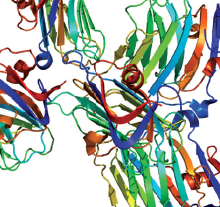Journal Digest
First Genetic Links With Tourette Syndrome Identified

An international team of researchers has identified some of the first definitive genetic risk variants for Tourette syndrome.
Deletion of a portion of the NRXN1 gene or a duplication in a segment of the CNTN6 gene increased the risk of Tourette syndrome by 20- and 10-fold, respectively, the authors reported in the journal Neuron.
The findings arose from an analysis of 2,434 individuals with Tourette syndrome and 4,093 controls.
NRXN1 and CNTN6 are important genes for brain development as they produce proteins involved in the formation of synapses. In particular, these genes help the brain form connections between the frontal cortex and regions involved in processing emotions and movement. Studies have suggested that errors in these connections may underlie the distinct vocal and motor tics associated with Tourette syndrome.
About 1 percent of all people with Tourette syndrome carry one of these risk variants, the study authors noted.
Huang A, Yu D, Davis L, et al. Rare Copy Number Variants in NRXN1 and CNTN6 Increase Risk for Tourette Syndrome. Neuron. June 2017; 94(6):1101-1111.e7.
Magnesium Supplements May Improve Depression

A clinical study published in PLoS One has found that magnesium supplements can improve symptoms in people with mild-to-moderate depression.
A research team at the University of Vermont enrolled 126 adults with a Patient Health Questionnaire-9 (PHQ-9) score ranging from 5 to 19 in a 12-week crossover study. The participants were randomly assigned to take 248 mg of magnesium chloride daily during either the first or second six-week period of the trial.
The researchers found that average PHQ-9 scores improved by about 4.3 points among people taking magnesium at the end of each six-week period compared with 0.1 in the control groups. After adjusting for potential confounders including antidepressant use, the net PHQ-9 improvement of magnesium increased to 6.0 points. Similar effects were observed regardless of age, gender, baseline severity of depression, or baseline magnesium levels in the blood.
Overall, the supplements were well tolerated and most participants reported they would use magnesium in the future.
The authors cautioned that this study was not blinded and did not have a true placebo control, and additional work is needed to assess long-term effects and understand the mechanism of action.
Tarleton E, Littenberg B, MacLean C, et al. Role of Magnesium Supplementation in the Treatment of Depression: A Randomized Clinical Trial. PLoS One. June 2017; 12(6): e0180067.
D-Cycloserine Enhances Food Aversion Therapy in Children

A small clinical study of 15 children with avoidant/restrictive food intake disorder found that adding D-cycloserine (DCS) to behavioral intervention (BI) can augment the extinction of food aversion.
Children aged 20 months to 58 months were randomly assigned to daily BI with DCS or placebo administered over the course of five days. The BI sessions, which involved both extinction and reinforcement techniques to promote positive contact with food, were administered during mealtime, three times a day.
Compared with the placebo group, children who received adjunctive DCS showed greater improvements in food acceptance (as measured in percentage of bites with rapid swallowing) and problem behaviors (measured as number of mealtime disruptions). Visible improvements were seen in the DCS group by the second meal.
The investigators, led by a group at Emory University School of Medicine, next examined the effects of DCS on a mouse model of food avoidance. They found that DCS enhances the plasticity of neurons in the orbitofrontal cortex, a hub where sensory and cognitive data are integrated.
“[G]oal-directed action likely has a key role in overcoming avoidance and in learning to consume food,” the authors wrote. “Overall, the current results suggest that DCS can facilitate extinction, resulting in decreased time to effect and overall food acceptance.”
This study was published in Translational Psychiatry.
Sharp W, Allen A, Stubbs K, et al. Successful Pharmacotherapy for the Treatment of Severe Feeding Aversion With Mechanistic Insights From Cross-Species Neuronal Remodeling. Transl Psychiatry. June 2017; 7(6):e1157.
Suicide Risk Heightened Across Many Physical Health Conditions

At least 17 physical health conditions are associated with an increased risk of suicide, reports a study in the American Journal of Preventative Medicine.
“This study provides the first available evidence of the risk of suicide among individuals with major physical health conditions in the U.S. general population,” wrote the authors, led by investigators at Henry Ford Health System in Detroit.
The authors compared the health care use by 2,674 people who died by suicide between 2000 and 2013 with 267,400 matched controls. All participants were enrolled in health care systems that are part of the Mental Health Research Network.
Among 19 health conditions assessed (which were chosen because other groups have studied their relation to suicide risk), 17 were individually associated with increased suicide risk after adjusting for age and sex (osteoporosis and multiple sclerosis were the only exceptions). After further adjusting for mental health and/or substance use diagnoses, nine conditions remained significantly associated with increased suicide risk. These conditions included back pain, cancer, congestive heart failure, chronic obstructive pulmonary disease, epilepsy, HIV/AIDS, migraine, sleep disorders, and traumatic brain injury (TBI). Of these, TBI led to the greatest risk of suicide, with an 8.8-fold increase.
More than 38 percent of individuals who died by suicide had more than one of the 19 physical conditions examined, and physical comorbidity was associated with a fourfold increased risk of suicide.
“Given that individuals with multiple conditions are often seen by providers in various general and specialty settings, there should be numerous opportunities to integrate suicide prevention into their care,” the authors wrote.
Ahmedani B, Peterson E, Hu Y, et al. Major Physical Health Conditions and Risk of Suicide. Am J Prev Med. June 2017; S0749-3797(17)30222-2. [Epub ahead of print]
Epigenetic Changes Occur After Trauma, May Underlie PTSD Risk

Recent evidence suggests that epigenetic changes play a key role in adaptation to stressful events and thus may contribute to posttraumatic stress disorder (PTSD).
Investigators at Maastricht University in the Netherlands analyzed blood samples from military service members both before and after they were deployed to a combat zone. This enabled them to identify three genomic regions where post-stress epigenetic changes might signal PTSD susceptibility.
The investigators first sequenced DNA from 93 Dutch service members deployed to Afghanistan and identified 12 regions where changes in DNA methylation were associated with increases in PTSD symptoms. These regions were associated with genes involved in biological pathways with clear relevance to brain activity and stress, including serotonin transport or circadian rhythms.
A second DNA analysis in an independent sample of 98 U.S. marines in Afghanistan confirmed the association between methylation change and PTSD in three of these regions: ZFP57, RNF39, and HISTH2APS2—all genes located on chromosome six.
“Overall, this study is effective in highlighting those loci that have strong and consistent association with disease risk,” the authors wrote. “Identification of these loci thereby provides new leads for the understanding of the mechanisms of differential responses to traumatic stress and how epigenetic alterations may play a role in the development of PTSD.”
These findings were published in Molecular Psychiatry. ■
Rutten B, Vermetten E, Vinkers C, et al. Longitudinal Analyses of the DNA Methylome in Deployed Military Servicemen Identify Susceptibility Loci for Post-Traumatic Stress Disorder. Mol Psychiatry. June 20, 2017. [Epub ahead of print]



